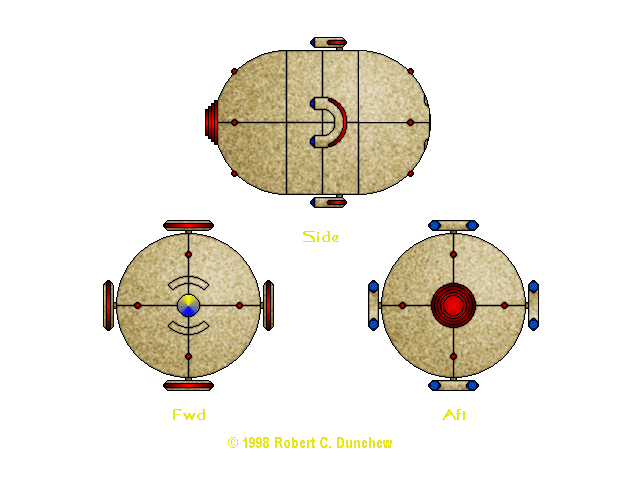

Lewis class
Inscription on commissioning Plaque: "The Future . . . something which everyone reaches at the rate of sixty minutes an hour, whatever he does, whoever he is."-- C.S. LEWIS
General Specifications:
Length: 56.25m
Width: 43m
Height: 43m
Max Warp: 6.5
Cruise: 5
Max. Impulse: 0.995 lightspeed
Crew: 3 officers and 8 enlisted
Armaments: Eight phaser cannon (4 fwd, 4 aft), one heavy photon cannon (10 Terawatt output), and 200+ enhanced quantum torpedoes in internal bays. Fire control systems are augmented by 12 SARPEVs.
Type: System defense monitor
Status: The lewis is currently in limited production for deployment to strategically important systems.
About Ship: The Lewis class starship is the culmination of the Hephaestus project. The objective was to create a vessel suited to the defense of vital systems, with the ability to deter, or at least delay an enemy until help could arrive.
The Lewis has a variety of multiply redundant systems, to permit it to continue fighting effectively even when heavily damaged. The hull is a multilayered shell of interlocking foamed tritanium tiles within multiple layers of ablative armor. Life support systems are multiply redundant as well, and the crew wears vacuum environment suits when combat is imminent. The bridge and engineering sections are buried within the hull, as much as possible. Due to the limited space within the hull, there is no real distinction between the bridge and the engineering section, as they are located within arm's reach of each other.
The vessel itself is very compact, consisting of two partial spheres joined to create a hull with very little surface area for the internal volume. Contrary to standard ship design, the decks are oriented with "up" in the direction of travel, rather than at 90 degrees to direction of travel. This is primarily due to the limited space available within the hull, but also because the ship is capable of landing on a planetary surface in the "tail-down" position. This landing position allows the Lewis to be prepared for immediate interception of hostile vessels while hiding in the gravity well of a planet. The hull is reinforced to allow it to "float" within a gas giant's upper atmosphere for additional camouflage, while auxiliary vessels (SARPEVs) scan for hostile vessels.
The four horseshoe-shaped objects around the Lewis's "waist" are warp nacelles. The unconventional shape and number (four) of the nacelles creates a highly unusual warp field configuration, allowing warp velocity to be used deep within a gravity well without adverse effects. This enables the Lewis to respond quickly anywhere within a star system without being restricted to sublight velocities near planets and stars, though maximum possible warp is severely limited.
The computer core is a holistic system of distributed sub-cores, allowing the ship to continue functioning even if 70% of all subcores are damaged or destroyed. Computer switching is by networked bioneural gelpacks enhanced with a subtle warping of subspace along all data busses. Theoretically, this system can perform calculations almost instantly. Processing ability is limited, however, by the necessity to provide data to sentient beings whose thought processes require some decision-making time.
Power generation and distribution is by an artificial quantum singularity coupled to massive quantum flywheels. This arrrangement is necessary due to the enormous power requirements of the photon cannon, the most powerful of its type developed to date, at 10 Terawatts output. Fire control is provided by multifunction phased arrays (MFPA) on the outer hull layers, augmented by SARPEVs for extremely long-ranged sensing. The total output of the phaser cannon is high enough to damage the MFPA if all are fired through the same segment. To allow the full power of the phaser cannon battery to be used in normal operations, each cannon is provided with its own dedicated emitter.
The Lewis is not intended to operate alone, but in concert with a starbase and supported by other point-defense vessels, such as fighters or cutters.
Return to the Starship Catalogue.